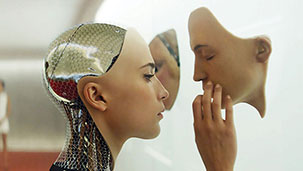It’s not easy to replicate human movement. There’s a non-mathematical rhythm to people’s physical motion that reflects their inner emotions – from nervous ticks, to sloppy posture, to general social awkwardness. It’s what makes us human.
An actor’s job is to master these subconscious tells, and in Ex Machina, you’re one of the many digital artists responsible tracking those very calculated movements. By compositing a mechanical structure to actress Alicia Vikander’s body, your mission is to make her character, Ava, look both real and distinctly… not. You’re creating a reverse Turing test on the audience. When you succeed, it’s a thing of beauty. But nowadays, that’s the easy part. The failure is that I had to spend so much time, both during and after the film, trying to understand the basic story logic.
As a scientific experiment, it might sound fascinating for an eccentric tech billionaire to bring an unsuspecting employee to a remote location to determine if his latest invention possesses true artificial intelligence. But as a film treatment, it’s sorely lacking a dramatic thesis.
We know the robot was reverse engineered from an actor’s performance. Her face is completely recognizable, and her movements are that of a flesh-and-blood woman. So while we might initially spend some time admiring your digital effects work on the legs, arms and abdomen, we never actually question the humanity on display. Our journey is inverse from that of the protagonists – do we buy her as a robot? But while the characters are looking for the intangible elements that would reveal true emotional and developed intelligence (rather than programmed responses), we have time to ponder banal questions like – how could one solitary man ever create such an elaborate and secretive replica of the human eye (for example), complete with reds in the corners and veins? You know, the stuff you didn’t bother to touch up.
Then I ask myself, why is true A.I. so much more impressive than whatever this nearly-A.I. being is that we’re seeing? Based on Domhnall Gleeson’s reactions, it’s clearly an unparalleled feat in-and-of itself. So even if the story takes place in the near future (it never specifies), Oscar Isaac’s character would be the equivalent of Henry Ford withholding the release of the Model T until it could run on pure oxygen and emit zero emissions. And that’s where the film becomes too mechanical in its execution
We’ve seen a few female characters (usually played by Scarlett Johansson) in the last year going on this same journey to discover what it means to be human. The novelty has become ho-hum from an audience perspective. But what works about the film is when writer and director Alex Garland contrasts clinical art direction with a seemingly laid-back mystery man at the center. It tells us something is off. Cracked glass in a window, and excessive drinking provide the types of flaws that makes surroundings and characters compelling. But finding flashes of life in the human characters is far less interesting than what we might have seen in a robot.
Moving on,
Christopher







